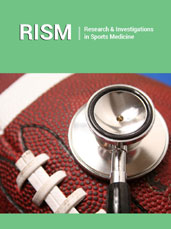- Submissions

Abstract
Research & Investigations in Sports Medicine
Regression of Sports Vagotonia
-
Open or CloseKataev DA1,2, Tsirkin VI3*, Trukhin AN1 and Trukhina SI4
1Vyatka State University, Russia
2Kirov Regional State Autonomous Institution of Additional Education “Sports School of Olympic Reserve “Perekop”, Russia
3Kazan State Medical University, Russia
4Kirov State Medical University, Ministry of Health of the Russian Federation, Russia
*Corresponding author:Tsirkin VI, Kazan State Medical University, Russia
Submission: February 28, 2025;Published: March 27, 2025

ISSN: 2577-1914 Volume11 Issue2
Abstract
Registration of Heart Rate Variability (HRV) in clinostasis conditions revealed that after 7 months from the moment of the forced complete cessation of all training loads, the median of 10 indicators (out of 15)-clino-HRV (TP, APHF, HF%, APVLF, APLF, RRNN, pNN50%, RMSSD, SDNN, and MxDMn) statistically significantly decrease to the level typical for non-athletes, while the medians of 3 indicators (VLF%, HR, SI) increase and only the medians of 2 indicators (LF%, AMLF/AMHF) do not change. During the same period, 11 indicators of ortho-HRV decreased to the level typical for non-athletes (TP, APHF, HF%, APVLF, VLF%, APLF, RRNN, pNN50%, RMSSD, SDNN and MxDMn) and the medians of 4 indicators (LF%, APLF/APHF, HR and SI) increased. Heterochrony is characteristic of changes in the indicators of clino-and ortho-HRV. The first statistically significant changes in the median of HRV-indicators are observed a month after the cessation of training loads and they increase gradually, reaching a plateau after 2-5 months. The cessation of training loads was accompanied by a decrease in the activity of the Sympathetic Division (SD) of the Autonomic Nervous System (ANS) and especially, a decrease in the activity of the Parasympathetic Division (PD) of the ANS, including, probably, a decrease in the synthesis of non-neuronal acetylcholine (NN-ACh), the presence of which, however, even after 7 months of cessation of training is still present in K.D., although its level is significantly reduced SD. So, if, as is well known, long-term aerobic training loads are required for the formation of sports vagotonia, then a relatively short period of time is sufficient for its regression, judging by the data of the elite skier K.D.-no more than 7 months in the complete absence of endurance training.
Keywords:Heart rate variability; Clinostasis; Active orthostasis; Cross-country skiers; Autonomic nervous system; Parasympathetic and sympathetic divisions; Non-neuronal acetylcholine; Regression of sports vagotonia
 a Creative Commons Attribution 4.0 International License. Based on a work at www.crimsonpublishers.com.
Best viewed in
a Creative Commons Attribution 4.0 International License. Based on a work at www.crimsonpublishers.com.
Best viewed in 







.jpg)






























 Editorial Board Registrations
Editorial Board Registrations Submit your Article
Submit your Article Refer a Friend
Refer a Friend Advertise With Us
Advertise With Us
.jpg)






.jpg)














.bmp)
.jpg)
.png)
.jpg)










.jpg)






.png)

.png)



.png)






